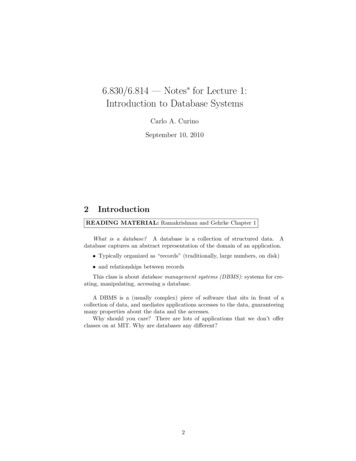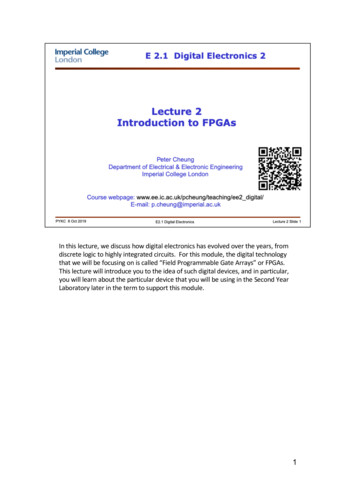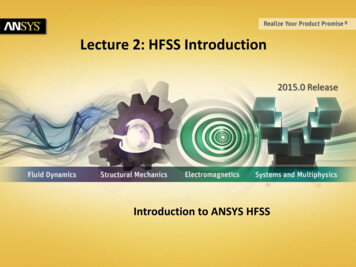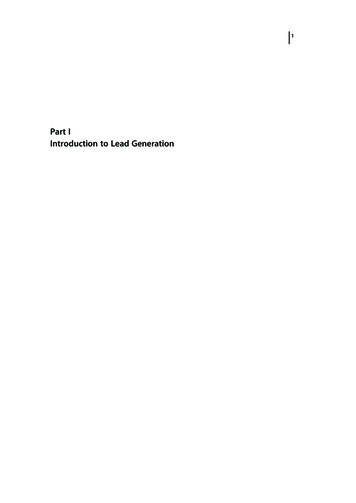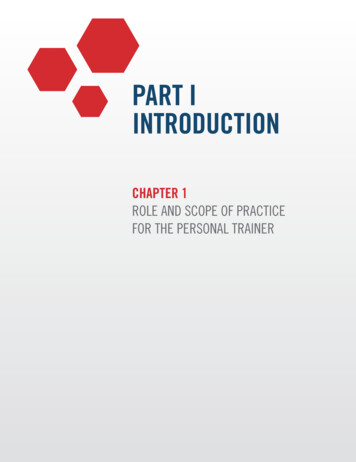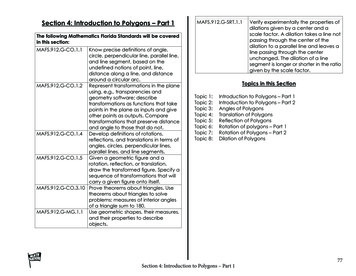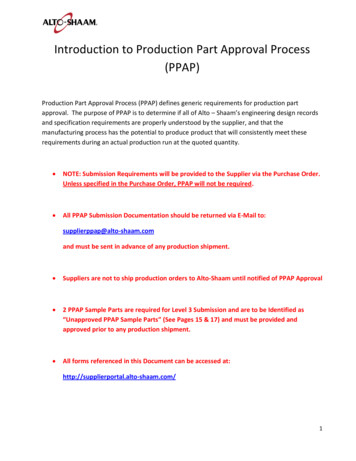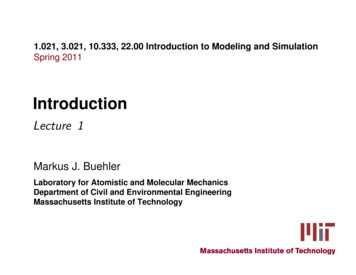
Transcription
1.021, 3.021, 10.333, 22.00 Introduction to Modeling and SimulationSpring 2011IntroductionLecture 1Markus J. BuehlerLaboratory for Atomistic and Molecular MechanicsDepartment of Civil and Environmental EngineeringMassachusetts Institute of Technology1
Subject structure and grading schemePart I: Continuum and particle methods (Markus Buehler)Lectures 2-13Part II: Quantum mechanics (Jeff Grossman)Lectures 14-26The two parts are based on one another and will be taught in an integratedwayThe final grade will be based on:Homework (50%) and exams (50%)2
A few things we’d like you to remember The goal is to provide you with an excellent foundation for modelingand simulation, beyond the applications discussed in IM/S. Our goal: Discover the world of Modeling and Simulation with you– using a bottom-up approach.We will cover multiple scales -- the atomic scale, using Newton’s laws,statistical mechanics and quantum mechanics (involving electrons), aswell as continuum methods.You will be able to apply the knowledge gained in IM/S to many othercomplex engineering and science problems3
Subject content: Big picture Subject provides an introduction to modeling and simulation. Scientists and engineers have long used models to better understandthe system they study, for analysis and quantification, performanceprediction and design. However, in recent years – due to the advanceof computational power, new theories (Density Functional Theory,reactive force fields e.g. ReaxFF), and new experimental methods(atomic force microscope, optical tweezers, etc.) – major advances havebeen possible that provide a fundamentally new approach to modelingmaterials and structures. This subject will provide you with the relevant theoretical andnumerical tools that are necessary to build models of complex physicalphenomena and to simulate their behavior using computers. The physical system can be a collection of electrons and nuclei/coreshells, atoms, molecules, structural elements, grains, or acontinuum medium: As such, the methods discussed here are VERYFLEXIBLE! The lectures will provide an exposure to several areas of application,4based on the scientific exploitation of the power of computation,
Engineering science paradigm: Multi-scaleview of materialsBuehler and Ackbarow, Materials Today, 2007Courtesy of Elsevier, Inc.,http://www.sciencedirect.com.Used with permission.5
Characteristic scale of technology frontier (materials)Bridging the sistorsIntegrated circuitsIndustrializationnmIT revolutionÅAFM, SEMCNTs as electronicdevices Biology &nanotechBio-X revolutionStone agebronze agesemiconductor agenanotechnologyFig. 1.1 in Buehler, Markus J. Atomistic Modeling of Materials Failure. Springer, 2008. Springer. All rights reserved.This content is excluded from our Creative Commons license. For more information, see http://ocw.mit.edu/fairuse.
Content overviewI. Particle and continuum methods1.2.3.4.5.6.7.8.Atoms, molecules, chemistryContinuum modeling approaches and solution approachesStatistical mechanicsMolecular dynamics, Monte CarloVisualization and data analysisMechanical properties – application: how things fail (andhow to prevent it)Multi-scale modeling paradigmBiological systems (simulation in biophysics) – howproteins work and how to model themII. Quantum mechanical methods1.2.3.4.5.6.7.8.Lectures 1-13Lectures 14-26It’s A Quantum World: The Theory of Quantum MechanicsQuantum Mechanics: Practice Makes PerfectThe Many-Body Problem: From Many-Body to SingleParticleQuantum modeling of materialsFrom Atoms to SolidsBasic properties of materialsAdvanced properties of materialsWhat else can we do?7
Engineering science paradigm: Multi-scaleview of materials“molecular” (explicitlyresolve molecules/atoms)Molecular DynamicsPart I“continuum” (matterinfinitely divisible, nointernal structure)e.g. finite elementmethodsPart II“quantum” (explicitly resolve electrons);e.g. Density Functional Theory source unknown. All rights reserved. Thiscontent is excluded from our CreativeCommons license. For more information, seehttp://ocw.mit.edu/fairuse.8
A few important concepts in modeling andsimulationWhat is the difference betweenmodeling and simulation?9
Modeling and simulation The term modeling refers to the development of amathematical representation of a physical situation. On the other hand, simulation refers to the procedure ofsolving the equations that resulted from modeldevelopment.10
What is a model?Mike Ashby (Cambridge University): A model is an idealization. Its relationship to the real problem is like that ofthe map of the London tube trains to the real tube systems: a grosssimplification, but one that captures certain essentials.“Physical situation” Google, Inc. All rights reserved. This content is excludedfrom our Creative Commons license. For more information, seehttp://ocw.mit.edu/fairuse.“Model”11 Massachusetts Bay Transportation Authority. All rightsreserved. This content is excluded from our Creative Commonslicense. For more information, see http://ocw.mit.edu/fairuse.
What is a model?Mike Ashby (Cambridge University): The map misrepresents distances and directions, but it elegantlydisplays the connectivity. The quality or usefulness in a model is measured by its ability tocapture the governing physical features of the problem. Allsuccessful models unashamedly distort the inessentials in order tocapture the features that really matter. At worst, a model is a concise description of a body of data. At best,it captures the essential physics of the problem, it illuminates theprinciples that underline the key observations, and it predictsbehavior under conditions which have not yet been studied.12
What is a simulation? Simulation refers to the procedure of solving the equationsthat resulted from model development. For example, numerically solve a set of differentialequations with different initial/boundary conditions. BCs, ICs13
1.021, 3.021, 10.333, 22.00 Introduction to Modeling and SimulationSpring 2011Part I – Continuum and particle methodsIntroduction part IMarkus J. BuehlerLaboratory for Atomistic and Molecular MechanicsDepartment of Civil and Environmental EngineeringMassachusetts Institute of Technology14
Content overviewI. Particle and continuum methods1.2.3.4.5.6.7.8.Atoms, molecules, chemistryContinuum modeling approaches and solution approachesStatistical mechanicsMolecular dynamics, Monte CarloVisualization and data analysisMechanical properties – application: how things fail (andhow to prevent it)Multi-scale modeling paradigmBiological systems (simulation in biophysics) – howproteins work and how to model themII. Quantum mechanical methods1.2.3.4.5.6.7.8.Lectures 2-13Lectures 14-26It’s A Quantum World: The Theory of Quantum MechanicsQuantum Mechanics: Practice Makes PerfectThe Many-Body Problem: From Many-Body to SingleParticleQuantum modeling of materialsFrom Atoms to SolidsBasic properties of materialsAdvanced properties of materialsWhat else can we do?15
Multi-scale view of materialsBuehler and Ackbarow, Materials Today, 2007Courtesy Elsevier, Inc.,http://www.sciencedirect.com.Used with permission.16
Example application: Stiffness of materials(Young’s modulus)Objective: Illustrate the significance of multiple scales formaterial behavior and introduce multi-scale modelingparadigm17
Beam deformation problem – continuum modelAQuestion: Displacement fieldGoverning equation (PDE)Integration & BCsGeometryBC - load:E unknown parameterE is parameter called “Young’s modulus” that relates how force anddeformation are related (captures properties of material)18
How to determine Young’s modulus E ?Measurement (laboratory):Rod/beam (e.g. plastic,metal, nanowire)A cross-sectionYoung’s modulus E ( stiffness proportionality between19force and displacement)
How to determine E ? - alternative approachAtomistic simulation – new engineering paradigmImage from Wikimedia Commons, http://commons.wikimedia.org.Idea: Consider the behavior of a collection of atoms inside the beam as20deformation proceeds
Molecular dynamics simulation Newton’s laws: F ma Chemistry: Atomic interactions – calculate interatomic forcesfrom atomic interactions, that is, calculate F from energylandscape of atomic configuration (note that force andenergy are related )21
Linking atomistic and continuum perspective Atomistic viewpoint enables us to calculate how force and deformationis related, that is, we can predict E once we know the atomic structureand the type of chemical bonds Example, in metals we have metallic bonding and crystal structures –thus straightforward calculation of E Atomistic models provide fundamental perspective, and thereby ameans to determine (solely from the atomistic / chemical structure ofthe material) important parameters to be used in continuum modelsEnergy Ur1/r12 (or Exponential)RepulsionRadius r (Distancebetween atoms)eImage from Wikimedia Commons, http://commons.wikimedia.org.Attraction221/r6Image by MIT OpenCourseWare.
Quantum mechanics Deals with fundamental view of chemical bonding, basedon electrons in atomsdiene dienophileconjugated (substituted) diene (substituted) olefin Æ (substituted) cyclohexene“Schroedinger equation”23
Developing a potential energy from quantummechanicsOImage removed due to copyright restrictions. m Chemistry/Potential Energy Surfaces/water dimer/Resources/charts/DFT vs VQZ HF and MP4SDTQ resized.gif .rOr24
JAVA Applet http://webphysics.davidson.edu/WebTalks/AAPT CISE 2000/Molecular/intro.html25
copperforceExample: Stretching nanowiredeformation source unknown. All rights reserved. This content is excluded from our Creative Commonslicense. For more information, see http://ocw.mit.edu/fairuse.26
Multi-scale simulation paradigmyAyσyynyσyxσyzσxzσxynxσxxxAxzdiv σ f 0Image by MIT OpenCourseWare.“continuum scale”Matter is indefinitelyDivisibleMolecular model (fundamental) Æ Parameters (Young’smodulus) Æ Use in model with PDE that involvesYoung’s modulus as parameterCourtesy of Elsevier, Inc.,27http://www.sciencedirect.com.Used with permission.
Beam deformation problem – continuum modelAQuestion: Displacement fieldGoverning equation (PDE)Integration & BCsGeometryBC - load:E parameter (obtainedfrom atomistic simulation)E is parameter called “Young’s modulus” that relates how force and28deformation are related (captures properties of material)
Applications of continuum methods29
Cloth modeling for animated moviesImage of flag removed due to copyright restrictions. See http://www.moma.org/collection/object.php?object id 78805.30Aivazis, Lombeyda and RR, 2003
Airbag deployment dynamics Image courtesy of High Contrast. License: CC-BY.Image courtesy of High Contrast. License: CC-BY.31Public domain image.
Benefits of atomistic models32
Other material properties Atomistic models are not limited to calculation of E (orgenerally, elastic properties) Atomistic models also enable us to predict failure, fracture,adhesion, diffusion constants, wave speeds, phase diagram(melting), protein folding (structure), Glass – brittle (breaks easily)Metal – ductile (deformable)33
Failure of materials and structuresFailure uncontrolled response of a structure, often leading to malfunctionof entire device, system Public domain image.Image by quinn.anya on Flickr. License: ics, tiles)Bone fractureCollapse of buildingsImage by digitalsadhu on Flickr. License: CC-NC.Cost of failure of materials: 100 billion (1982)Image by Wha’ppen on Flickr.34
Failure proceeds by rupture and tear ofmolecular and atomistic structuresBreaking ofchemical bondsCourtesy of Elsevier, Inc.,http://www.sciencedirect.com. Usedwith permission.Failure of materials observed at macroscale is due to repeated breaking,shearing, tearing of bonds at atomistic scaleNanoscopic response of material’s building block is key for materialsfailure35
36
c fracture.mpeg37
Please see: Buehler, Markus J., Farid F. Abraham, et al. "Hyperelasticity Governs Dynamic Fractureat a Critical Length Scale.” Nature 426 (2003): 141-6.38Supersonic fracture: Discovered in atomistic simulation on supercomputers
Theory/MDImage removed due to copyright restrictions.Please see Fig. 9 in Buehler, Markus, and Huajian Gao. "Modeling Dynamic FractureUsing Large-Scale Atomistic Simulations." Chapter 1 in Shukla, Arun.Dynamic Fracture Mechanics.Hackensack, NJ: World Scientific, 2006.experimentImage removed due to copyright restrictions.Please see Fig. 2 in Petersan, Paul J., Robert D. Deegan,M. Marder, and Harry L. Swinney. "Cracks in Rubberunder Tension Exceed the Shear Wave Speed." Phys RevLett 93 (2004): 015504.39
Failure of biological structures in diseasesFailure of materials is critical for understanding function andmalfunction of biologyExample: Rapid aging disease progeria - Single point mutations (changes)in protein structure causes severe diseasesCell nucleus loses mechanical stability under loading (heart, muscles)PatientFracture in cell’s nucleusCreated under mechanical deformationFailure of protein moleculesBuilding blocks of lifeImage removed due to copyright restrictions.Reprinted by permission from MacmillanPublishers Ltd: Nature Materials.Source: Buehler, M., and Y. Yung. "Deformationand Failure of Protein Materials in PhysiologicallyExtreme Conditions and Disease." NatureMaterials 8, no. 3 (2009): 175-88. 2009.Courtesy of Elsevier, Inc.,http://www.sciencedirect.com. Used withpermission.40
CellsVimentinintermediatefilamentProtein molecule41Chemical bondingSource: Qin, Z., L. Kreplak, and M. Buehler. "Hierarchical StructureControls Nanomechanical Properties of Vimentin IntermediateFilaments." PLoSONE 4, no. 10 (2009).doi:10.1371/journal.pone.0007294. License CC BY.Filaments
How structural building blocks of cells break Genetic diseasesCourtesy of National Academy of Sciences, U. S. A. Used with permission.Source: Ackbarow, Theodor, et al. "Hierarchies, Multiple Energy Barriers, and RobustnessGovern the Fracture Mechanics of Alpha-Helical and Beta-Sheet Protein Domains." PNAS 104(2007): 16410-15. Copyright 2007 National Academy of Sciences, U.S.A. Molecular mechanisms of biology42
Force (pN)Unfolding of titin moleculeX: breakingXXTitin I27 domain: Veryresistant to unfoldingdue to parallel Hbonded strandsDisplacement (A)43Keten and Buehler, 2007
Folding of beta-sheet protein structure44
Movie45S. Keten and M.J. Buehler, in submission
A New Approach to Molecular SimulationVijay Pande, Associate Professor of Chemistry, Structural Biology, and Computer Science,Stanford UniversityFolding@home distributed computinghttp://folding.stanford.edu/46
Opportunity: Experimental techniquesSingle cellsSingle moleculesCourtesy of Elsevier, Inc.,http://www.sciencedirect.com.Used with permission.
Integration with experimental techniquesReprinted by permission from MacmillanPublishers Ltd: Nature Materials.Source: Buehler, M., and Y. Yung. "Deformationand Failure of Protein Materials in PhysiologicallyExtreme Conditions and Disease." NatureMaterials 8, no. 3 (2009): 175-88. 2009.48
For most applications, we will use awebsite-driven simulation frameworkdeveloped in collaboration with MIT’sOffice for Undergraduate EducationnanoHUB: https://nanohub.orgMore than 160 tools:https://nanohub.org/resources/toolsTechnical assistance: Justin Riley49
copperforceExample: Stretching nanowiredeformation source unknown. All rights reserved. This content is excluded from our Creative Commonslicense. For more information, see http://ocw.mit.edu/fairuse.50
MIT OpenCourseWarehttp://ocw.mit.edu3.021J / 1.021J / 10.333J / 18.361J / 22.00J Introduction to Modeling and SimulationSpring 2012For information about citing these materials or our Terms of use, visit: http://ocw.mit.edu/terms.
1 Introduction Lecture 1 1.021, 3.021, 10.333, 22.00 Introduction to Modeling and Simulation Spring 2011 Markus J. Buehler Laboratory for Atomistic and Molecular Mechanics




